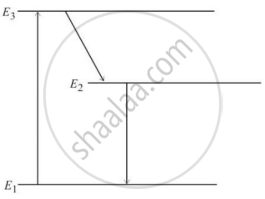Advertisements
Advertisements
प्रश्न
In an atom X, electrons absorb the energy from an external source. This energy “excites” the electrons from a lower-energy level to a higher-energy level around the nucleus of the atom. When electrons return to the ground state, they emit photons.
The figure below is the energy level diagram of atom X with three energy levels, E1 = 0.00eV, E2 = 1.78eV and E3 = 2.95eV. The ground state is considered 0 eV for reference. The transition of electrons takes place between levels E1 and E2.

- What wavelength of radiation is needed to excite the atom to energy level E2 from E1?
- Suppose the external source has a power of 100 W. What would be the rate of photon emission?
उत्तर
(1) To start the laser, the molecule will have to be excited from E1 to E3. The wavelength required is
λ = `("hc")/(Delta"E")`
= `(1.24 xx 10^(-6))/2.95`
= 420.3 nm
Laser transition takes place between E1 and E2. So the wavelength of the beam of laser-produced will be
λ = `("hc")/(Delta"E")`
= `(1.24 xx 10^(-6))/1.78`
= 696.6 nm
(2) energy of photon = 1.78 eV
= 1.78 × 1.602 × 10-19 J
= 2.8516 × 10-19 J
photons emitted per second = `"power (energy emitted per second)"/"energy of each photon"`
= `(100 "W")/(2.8516 xx 10^(-19) "J")`
= 3.506 × 1020
APPEARS IN
संबंधित प्रश्न
Identify the part of the electromagnetic spectrum which is suitable for radar system used in aircraft navigation.
Why are infra-red waves often called heat waves? Explain.
Name the region beyond the red end of the spectrum.
State the approximate range of wavelength associated with infrared rays.
A free atom of iron emits Kα X-rays of energy 6.4 keV. Calculate the recoil kinetic energy of the atom. Mass of an iron atom = 9.3 × 10−26 kg.
(Use Planck constant h = 6.63 × 10-34 Js= 4.14 × 10-15 eVs, speed of light c = 3 × 108 m/s.)
Name any two electromagnetic waves which have a frequency higher than that of violet light. State one use of each.
State two properties of infrared radiations which differ from visible light.
Choose the correct option.
Earth’s atmosphere is richest in
One requires 11eV of energy to dissociate a carbon monoxide molecule into carbon and oxygen atoms. The minimum frequency of the appropriate electromagnetic radiation to achieve the dissociation lies in ______.
Give any two uses of infrared waves.
